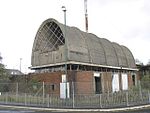Nantyglo Round Towers
1816 establishments in the United KingdomBuildings and structures in Blaenau GwentEngvarB from August 2016Tower houses in the United KingdomTowers completed in 1816

Nantyglo Round Towers are located at Roundhouse Farm, Nantyglo, near Brynmawr in the borough of Blaenau Gwent in the South Wales Valleys. The two fortified towers were constructed in the early 19th century as places of retreat by the ironmaster Joseph Bailey, after a riot was caused by his brother's threat to cut wages. They are believed to some of the last privately built defensive fortifications in Britain. One of the towers remains intact today whilst the other is in ruins having been partly demolished to salvage scrap iron in the 1940s.
Excerpt from the Wikipedia article Nantyglo Round Towers (License: CC BY-SA 3.0, Authors, Images).Nantyglo Round Towers
Woodland Terrace,
Geographical coordinates (GPS) Address External links Nearby Places Show on map
Geographical coordinates (GPS)
| Latitude | Longitude |
|---|---|
| N 51.78525 ° | E -3.17546 ° |
Address
Woodland Terrace
NP23 4QL , Nantyglo and Blaina
Wales, United Kingdom
Open on Google Maps







